Parent Category:
Background
In the late 1920’s when dog showing was considered a"wealthy-man’s sport" and parents arrived at shows in chauffeur-driven limousines, children who accompanied their parents became bored and restless, which resulted in a less than ideal show environment. In an effort to control the show environment and not offend the wealthy owners and breeders, Mr. Brumby Sr. of the American Kennel Club (AKC) introduced a special class of competition for these children. The purpose was to provide something of interest and amusement. Local celebrities, public officials and movie stars were used as judges. Many of these people had no idea what the competition entailed. In order to save the program from failure, Superintendent George Foley quietly became involved by proposing that in informal manner of selecting judges be changed. AKC realized that these"celebrity judges" proved to be lacking in knowledge. Next they decided to use handlers to judge the juniors. This was a better alternative, but with it came new problems. The handlers as judges were more qualified than the local celebrities, but they also sometimes had entries to manage at the same time as they were scheduled to judge a junior class. By 1951 the Children’s Handling Class had become widely popular, and in 1971 AKC changed the name to Junior Showmanship. The newly- named program required that the competitors in the ring be judged"only on the junior’s ability to present his dog quietly, proficiently and to its best advantage". The classes and eligibility for juniors were divided into two classes, Novice and Open, which were further divided by age. The junior class competitors must be at least ten years old and under thirteen years old on the day of the show and the senior class for competition must be at least thirteen years old and under seventeen years old on the day of the show. Picture #1 shows Joseph Sayres, of Peekskill, New York, who was the first Westminster winner (1935). Picture #2 shows Elise Jerozal of Taylors, SC, the AKC Eukanuba Obedience winner with her English Cocker (2013).
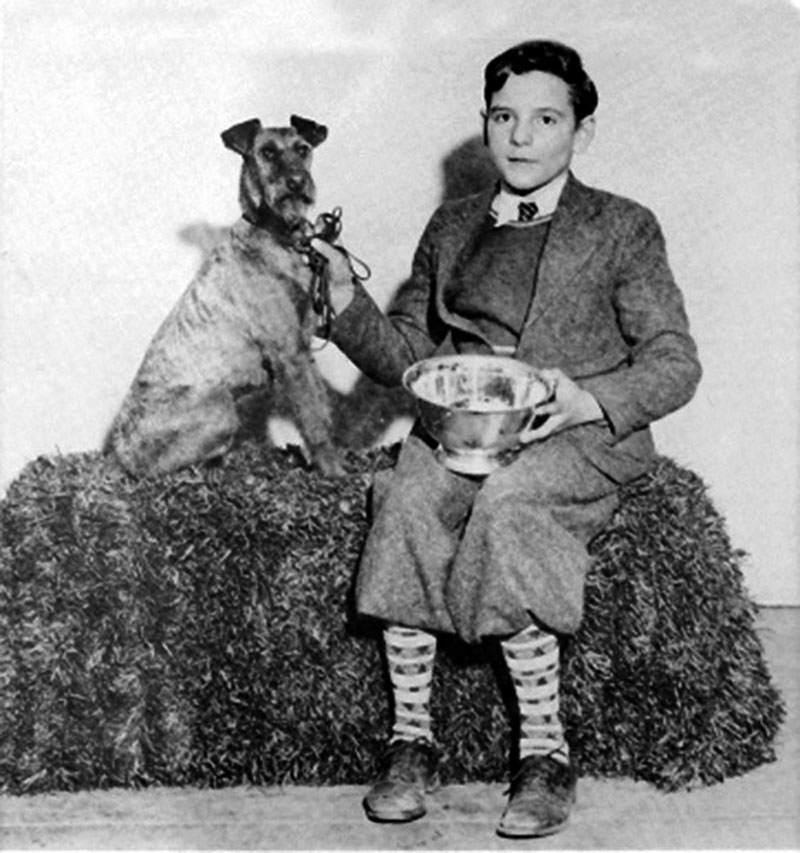
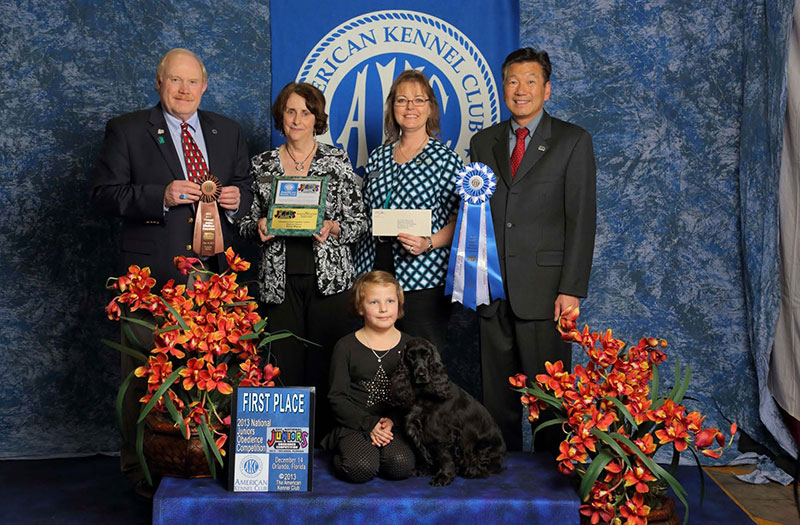
Introduction
There are no current studies evaluating success or the risk factors for dropout involving children who participate in dog sport programs. The idea of learning more about junior showmanship began at a delegate caucus in 2012. The subject was emotionally discussed and I thought now might be the time to conduct a longitudinal study as more than 80 years have passed since the AKC children’s program was begun . My study involved three other researchers from two Universities (U. of Penn and Florida State U.) I would serve as lead investigator. The discussion that follows was taken from the first preliminary report to the delegate body at the June 2014 caucus. Two follow-up papers will discuss the data analyzed and suggestions for the future which will be based on our analysis and findings.
The survey - The purpose of this study was to examine many of the factors that identify what juniors consider success and what factors influence the risk of dropout in the program. This was an internet survey which was anonymous for the juniors.One historical time restriction was applied in that juniors were recruited who had been out of the sport since the year 2000. The survey was initiated on January 29, 2012, and ended July11, 2012. More than 1,300 juniors responded. These juniors were directed to a series of 50 questions which were divided into three segments.
- The time period when competing in the sport
- The most recent five years
- Now, this is taken to mean at the time of the survey.
Discussions with representatives with 4H; Boy and Girl Scout organizations provided valuable insight into the needs of juniors. This survey effort was designed as an Internet-based cross-sectional survey of juniors in the AKC Junior Showmanship program. Table 1 shows the distribution of juniors and their current age at the time they responded to the survey. The median age of the respondents at the time of the survey was 39
| Age Group | Frequency | Percentages |
|---|---|---|
| 18-20 | 13 | 1.49 |
| 21-30 | 264 | 30.34 |
| 31-40 | 246 | 28.28 |
| 41-50 | 178 | 20.46 |
| 51-60 | 132 | 15.17 |
| 61-70 | 32 | 3.68 |
| 71-102 | 5 | 0.57 |
Trend data provided by AKC for the years 2000 – 2013 show a slow downward drift of juniors over the past 13 years. The entries and certificates offered juniors suggest that several factors may be impacting the program.The data shown in Graph2 and 3 suggest that this study might provide some useful information about the future.
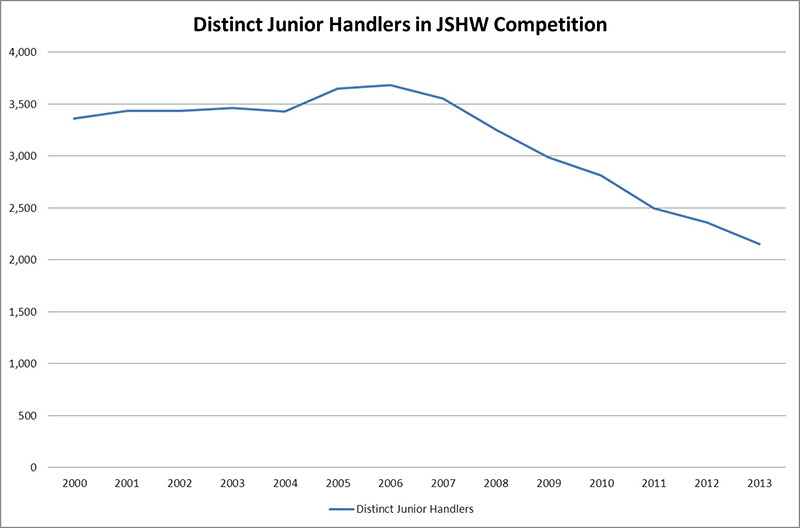
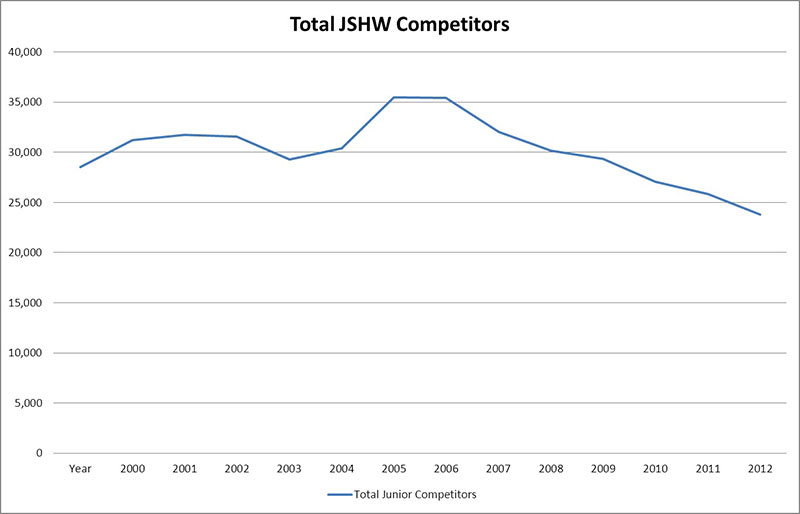
Based on the responses from the juniors, we noticed that there are many factors involved in a children’s sport that influences both success and dropout. One important element is the adult who accompanies the junior to the event. We call that person the volunteer because they provide an enormous amount of support, advice and understanding. Other important persons were the siblings and friends of juniors who are noted in tables 12 and 13.
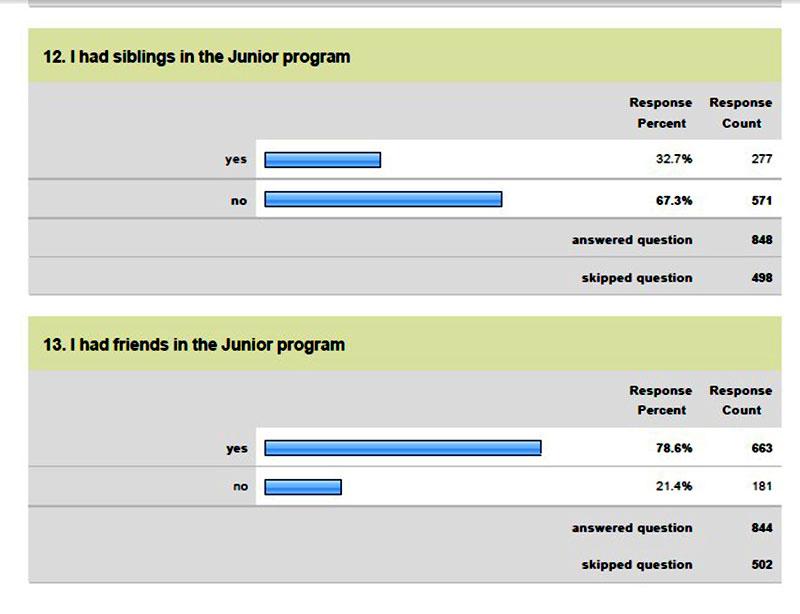
Additionally, information was collected from juniors by age, gender, participation in the sport, and family, socio-economic and environmental factors. Other factors as size and breed of the dog used in competition were analyzed to see if either was associated with success or the increased risk of dropout. The survey included predefined choices, write- in comments were not provided for in the survey. The survey also allowed respondents to leave questions incomplete.
Our survey findings suggest that several sport and social factors were significantly associated with success and participation in the program. Factors related to continued involvement in the sport after the juniors “aged-out” of eligibility were also evaluated. The involvement of family and friends was examined. Given the age range of the juniors, we were interested in continued participation over time. We found that there was significant difference between the sexes, 85% were girls and 15% boys. The most important factor to continued involvement in the program was winning and self-satisfaction. Success was defined as those who had spent three or more years in the show ring and were between 15 and 18 years of age. Our analysis confirmed many of the previously understood or assumed factors for continuing in the sport after “aging-out”. In fact, certain activities (i.e., family, success,) previously considered to be positively related to entry and continued involvement is in part supported by the data.
The interaction between a junior, family member, friend or peer represents an important component of commitment and assumes a lower risk of dropout. Therefore, social factors that are related to family, friends and peers would appear to increase the likelihood of success and continued participation in the sport. These factors need further study to see if there are stressful experiences, events, or perceived attitudes about the lack of winning that can be linked to the dropout rate and the gender differences. The data does not support a previous recommendation that by simply expanding the program we would assure a continuous supply of new juniors, more breeders, fans, and exhibitors. More about these and other variables will be reported in Part II.
More about these and other variables will be reported in Part II. At this time we can report that clubs interested in a strong junior program should consider the role of the adult volunteer who accompanies and supports the junior at each event. What will motivate these adults is likely to be a compelling idea. The same reason is not likely to motivate the junior who is driven by winning and self-satisfaction. The extreme gender difference (85% girls, 15% boys) is in part explained by two important social factors. Boys at this age want instant success and are easily embarrassed when they lose to a girl. Girls on the other hand are more patient and are not as easily embarrassed. My discussions with 4-H representatives support the following recommendation. If boys are to be recruited and retained, a better reward and recognition mechanism is needed. Create new categories other than “winner take all” which is based on the traditional conformation show format of ribbon placements - first through fourth. This has proven not to be an effective way to retain young males. One suggestion that would address the problem of boys dropping out early is to increase the number of rewards, ribbons and titles offered.
In my next report, Part III will report on more of the survey findings and some of the conclusions.
About the Author
Carmen L Battaglia holds a Ph.D. and Masters Degree from Florida State University. As an AKC judge, researcher and writer, he has been a leader in promotion of breeding better dogs and has written many articles and several books.Dr. Battaglia is also a popular TV and radio talk show speaker. His seminars on breeding dogs, selecting sires and choosing puppies have been well received by the breed clubs all over the country.

